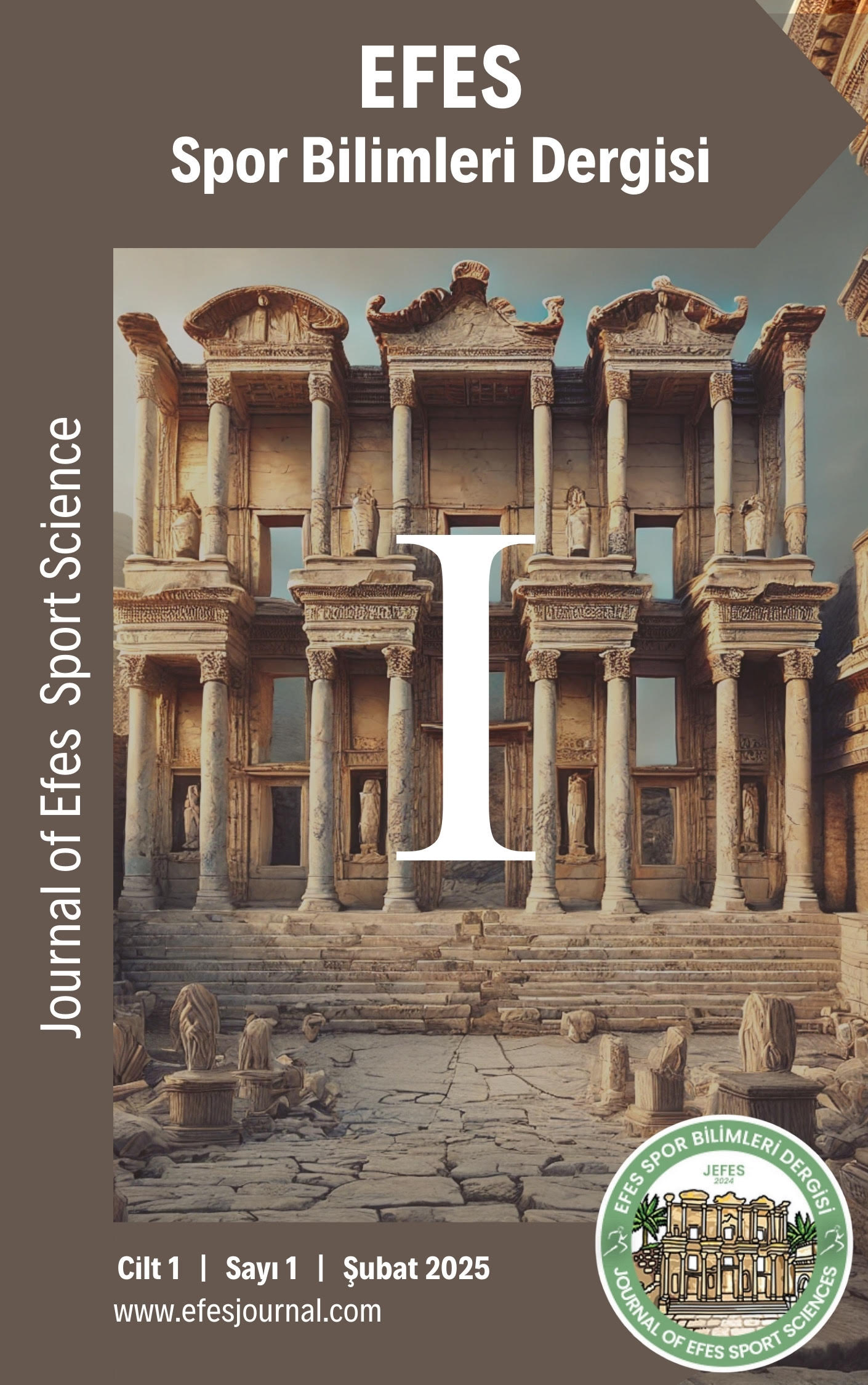INVESTIGATION OF STRENGTH PERFORMANCE OF CADET TAEKWONDO PLAYERS: COMPARISON OF SAĞIRKAYA METHOD AND TRADITIONAL METHOD
YILDIZLAR TAEKWONDO SPORCULARINDA KUVVET PERFORMANSININ İNCELENMESİ: SAĞIRKAYA YÖNTEMİ VE GELENEKSEL YÖNTEMİN KARŞILAŞTIRILMASI
DOI:
https://doi.org/10.5281/zenodo.15038018Anahtar Kelimeler:
Isokinetic, Strength Imbalances, Sağırkaya Method, Taekwondo Kyorugi, Weight-Based Classification.Özet
The Sağırkaya Method was developed as an alternative to the traditional weight-based classification method commonly used in taekwondo kyorugi competitions. This method classifies athletes based on their height rather than body weight. This study aimed to compare the Sağırkaya Method with the Traditional Method in terms of potential strength imbalances between competitors. The research was conducted with the voluntary participation of 20 elite cadet athletes (height: 156.19±13.61 cm; body weight: 52.62±6.25 kg; BMI: 21.68±4.74 kg/m²). After determining the athletes' height and body weight, their isokinetic knee and hip strength performance was assessed. The isokinetic strength was evaluated by measuring peak torque at angular velocities of 60º/s and 180º/s. The findings indicated moderate to strong significant correlations between body weight and knee (r=0.498-0.736; p<0.05) and hip (r=0.465-0.621; p<0.05) strength. However, when examining the relationships between height and knee and hip strength, no significant correlations were found (p>0.05). In conclusion, body weight appears to be an important factor in strength production among cadet taekwondo athletes. Since the Sağırkaya Method reveals differences in body weight between competitors more clearly compared to the Traditional Method, it was concluded that this method could lead to greater strength asymmetry between opponents, potentially creating an unfair competition environment.
Referanslar
Akoglu, H. (2018). User’s guide to correlation coefficients. Turkish Journal of Emergency Medicine, 18(3), 91-93. https://doi.org/10.1016/j.tjem.2018.08.001
Albuquerque, M. R., Lage, G. M., Costa, V. T. da, Ferreira, R. M., Penna, E. M., Moraes, L. C. C. de A., & Malloy-Diniz, L. F. (2012). Relative age effect in olympic taekwondo athletes. Perceptual and Motor Skills, 114(2), 461-468. https://doi.org/10.2466/05.25.PMS.114.2.461-468
Armstrong, N. (2007). Paediatric Exercise Physiology (1st edition). Edinburgh, New York: Churchill Livingstone.
Balyi, I., & Way, R. (2005). The Role of Monitoring Growth in Long-Term Athlete Development. Canada: Canadian Sport for Life.
Barley, O. R., & Harms, C. A. (2021). Profiling Combat Sports Athletes: Competitive History and Outcomes According to Sports Type and Current Level of Competition. Sports Medicine - Open, 7(1), 63. https://doi.org/10.1186/s40798-021-00345-3
Ferland, P.-M., Pollock, A., Swope, R., Ryan, M., Reeder, M., Heumann, K., & Comtois, A. S. (2020). The relationship between physical characteristics and maximal strength in men practicing the back squat, the bench press and the deadlift. International Journal of Exercise Science, 13(4), 281-297.
Ghazzawi, H. A., Amawi, A. T., Alduraidi, H., Juweid, M., Alhawari, H. H., Al-Abbadi, M. A., … AlNemer, L. S. S. (2023). The preventable effect of taekwondo sport among cadets and junior’ bone mineral density: DEXA assessment. Children, 10(1), 170. https://doi.org/10.3390/children10010170
Gutiérrez-Santiago, A., Pereira-Rodríguez, R., & Prieto-Lage, I. (2020). Detection of the technical and tactical motion of the scorable movements in taekwondo. Physiology & Behavior, 217, 112813. https://doi.org/10.1016/j.physbeh.2020.112813
Hammami, N., Ouergui, I., Zinoubi, B., Zouita Ben Moussa, A., & Ben Salah, F.-Z. (2014). Relationship between isokinetic and explosive strength among elite Tunisian taekwondo practitioners. Science & Sports, 29(3), 150-155. https://doi.org/10.1016/j.scispo.2013.07.013
Hammami, N., Zinoubi, B., Hamdi, F., Nouri, A., Zouita, A., & Dziri, C. (2013). Isokinetic profile of knee muscles in olympic elite taekwondo practitioners. Science & Sports, 28(4), 188-195. https://doi.org/10.1016/j.scispo.2013.01.003
Kazemi, M., Casella, C., & Perri, G. (2009). 2004 olympic taekwondo athlete profile. The Journal of the Canadian Chiropractic Association, 53(2), 152.
Kazemi, M., Waalen, J., Morgan, C., & White, A. R. (2006). A profile of olympic taekwondo competitors. Journal of Sports Science and Medicine, 5(CSSI-1), 114-121.
Klein, S. E. (2016). Defining Sport: Conceptions and Borderlines. Lexington Books.
Langan-Evans, C., Close, G. L., & Morton, J. P. (2011). Making weight in combat sports. Strength & Conditioning Journal, 33(6), 25. https://doi.org/10.1519/SSC.0b013e318231bb64
Lystad, R. P., Alevras, A., Rudy, I., Soligard, T., & Engebretsen, L. (2021). Injury incidence, severity and profile in Olympic combat sports: A comparative analysis of 7712 athlete exposures from three consecutive Olympic games. British Journal of Sports Medicine, 55(19), 1077-1083. https://doi.org/10.1136/bjsports-2020-102958
Malina, R. M., Bouchard, C., & Bar-Or, O. (2004). Growth, Maturation, and Physical Activity. Human Kinetics.
Ölmez, C. (2021). Determining the motor skills affecting the distance to the opponent in taekwondo. Pakistan Journal of Medical and Health Sciences, 15(10), 2999-3003. https://doi.org/10.53350/PJMHS2115102999
Ölmez, C. (2023). Examination of quadriceps and hamstring force performances of taekwondo athletes: a meta analysis study. Turkiye Klinikleri Journal of Sports Sciences, 15(2), 202-213. https://doi.org/10.5336/sportsci.2022-93959
Ölmez, C., Hammami, N., Yücelsoy, B., Hattabi, S., Forte, P., Sortwell, A., … İnce, A. (2023). Examining the link between isokinetic strength metrics and ball speed in women’s soccer. Applied Sciences, 13(22), 12217. https://doi.org/10.3390/app132212217
Patron, J., Wakely, A., Hernandez, E., & Lockie, R. (2022). Relationships between body size, strength, and power with throwing velocity following a strength training block in high school water polo players. International Journal of Exercise Science: Conference Proceedings, 14(2). Geliş tarihi gönderen https://digitalcommons.wku.edu/ijesab/vol14/iss2/67
Sağırkaya, A. (2023). Comparison of BMI and success performances of adolescent taekwondo players in competitions organized in terms of weight and height categories [Unpublished master thesis]. Manisa Celal Bayar University, Manisa.
Ten Hoor, G. A., Plasqui, G., Schols, A. M. W. J., & Kok, G. (2018). A Benefit of being heavier is being strong: A cross-sectional study in young adults. Sports Medicine - Open, 4, 12. https://doi.org/10.1186/s40798-018-0125-4
World Medical Association. (2013). World Medical Association Declaration of Helsinki: Ethical principles for medical research involving human subjects. JAMA, 310(20), 2191-2194. https://doi.org/10.1001/JAMA.2013.281053
Ek Dosyalar
Yayınlanmış
Nasıl Atıf Yapılır
Sayı
Bölüm
Lisans
Telif Hakkı (c) 2025 Şeyma Tuba Acar, Ölmez Cengiz

Bu çalışma Creative Commons Attribution 4.0 International License ile lisanslanmıştır.



